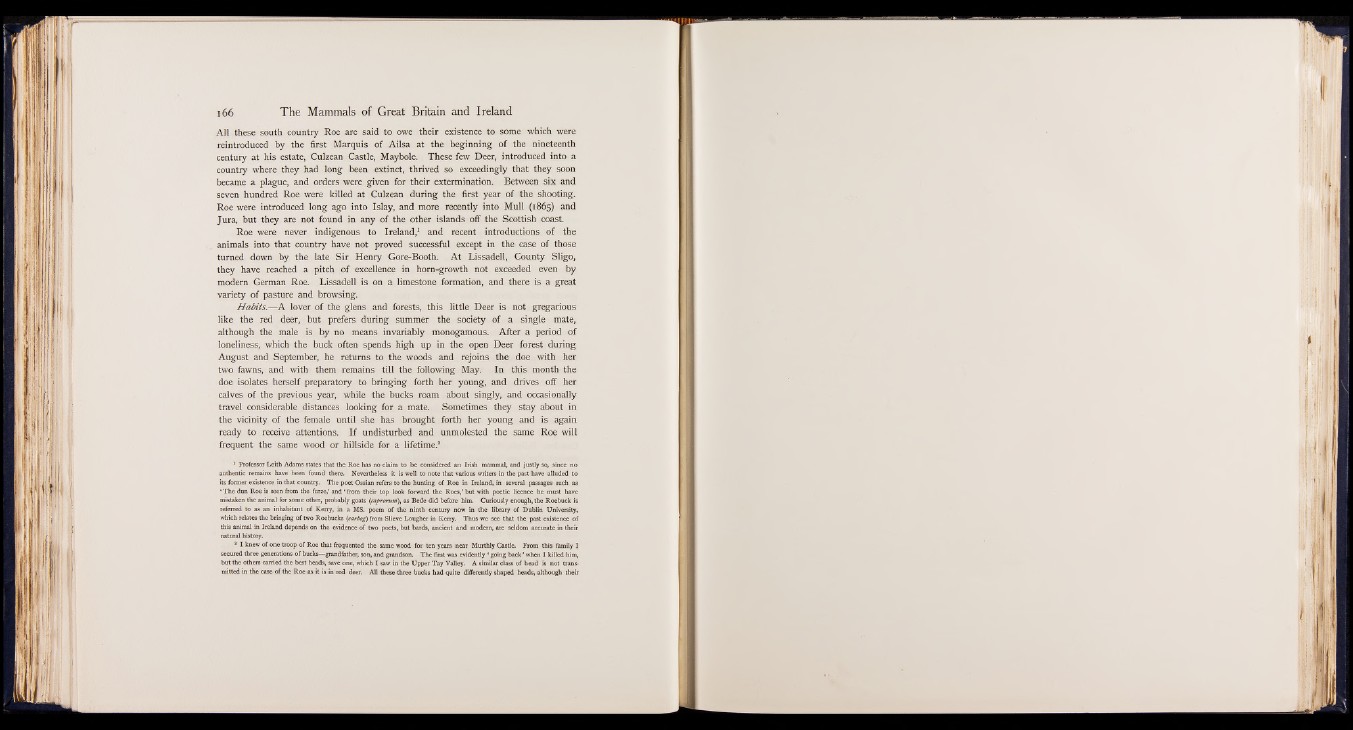
The Mammals of Great 166 Britain and Ireland
All these south country Roe are said to owe their existence to some which were
reintroduced by the first Marquis of Ailsa at the beginning of the nineteenth
century at his estate, Culzean Castle, Maybole. These few Deer, introduced into a
country where they had long been extinct, thrived so exceedingly that they soon
became a plague, and orders were given for their extermination. Between six and
seven hundred Roe were killed at Culzean during the first year of the shooting.
Roe were introduced long ago into Islay, and more recently into Mull (1865) and
Jura, but they are not found in any of the other islands off the Scottish coast.
Roe were never indigenous to Ireland,1 and recent introductions of the
animals into that country have not proved successful except in the case of those
turned down by the late Sir Henry Gore-Booth. At Lissadell, County Sligo,
they have reached a pitch of excellence in horn-growth not exceeded even by
modern German Roe. Lissadell is on a limestone formation, and there is a great
variety of pasture and browsing.
Habits.— A lover of the glens and forests, this little Deer is not gregarious
like the red deer, but prefers during summer the society of a single mate,
although the male is by no means invariably monogamous. After a period of
loneliness, which the buck often spends high up in the open Deer forest during
August and September, he returns to the woods and rejoins the doe with her
two fawns, and with them remains till the following May. In this month the
doe isolates herself preparatory to bringing forth her young, and drives off her
calves of the previous year, while the bucks roam about singly, and occasionally
travel considerable distances looking for a mate. Sometimes they stay about in
the vicinity of the female until she has brought forth her young and is again
ready to receive attentions. If undisturbed and unmolested the same Roe will
frequent the same wood or hillside for a lifetime.1 2 * 4
1 Professor Leith Adams states that the Roe has no claim to be considered an Irish mammal, and justly so, since no
authentic remains have been found there. Nevertheless it is well to note that various writers in the past have alluded to
its former existence in that country. The poet Ossian refers to the hunting of Roe in Ireland, in several passages such as
‘ The dun Roe is seen from the furze,’ and ‘ from their top look forward the Roes,’ but with poetic licence he must have
mistaken the animal for some other, probably goats (caprorum), as Bede did before him. Curiously enough, the Roebuck is
referred to as an inhabitant of Kerry, in a MS. poem of the ninth century now in the library of Dublin University,
which relates the bringing of two Roebucks (tarbog) from Slieve Lougher in Kerry. Thus we see that the past existence of
this animal in Ireland depends on the evidence of two poets, but bards, ancient and modem, are seldom accurate in their
natural history.
4 I knew of one troop of Roe that frequented the same wood for ten years near Murthly Castle. From this family I
secured three generations of bucks— grandfather, son, and grandson. The first was evidently * going back’ when I killed him,
but the others carried the best heads, save one, which I saw in the Upper Tay Valley. A similar class of head is not transmitted
in the case of the Roe as it is in red deer. All these three bucks had quite differently shaped heads, although their